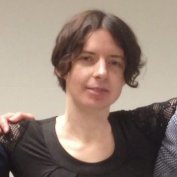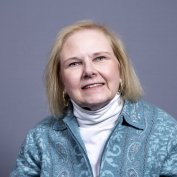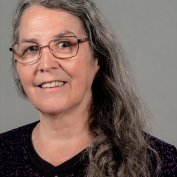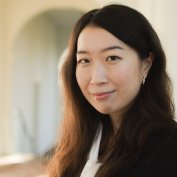The organization is open to all regardless of sex, gender, race, color, national origin or other characteristic, and is consistent with federal and state nondiscrimination laws.
Ivana Alexandrova
Associate Professor
Department of Mathematics & Statistics
I research partial differential equations, scattering theory, semi-classical and microlocal analysis, magnetic Hamiltonians, and the Aharonov-Bohm effect. I am also interested in helping to improve the mathematics education in American high schools.

Ilham Almahamid
Research Associate Professor
College of Integrated Health Sciences, Department of Environmental Health Sciences
My research areas focus on radioactive waste and human exposure to radioactive isotopes. Additionally, I founded "New York for Syrian Refugees" to assist the families in becoming part of a strong New York Community.

Jeanette Altarriba
Dean of College of Arts and Sciences; Professor
Department of Psychology, College of Arts and Sciences, Department of Africana, Latin American, Caribbean, and Latinx Studies
I research bilingualism, cognition, language, memory, and emotion. As Dean of the College of Arts and Sciences, I am committed to service. I was honored with an APA Lifetime Achievement Award for my research on bilingualism and strategic language use.

Cheryl P. Andam
Associate Professor and Scientific Director of the Life Sciences Research Initiative
Department of Biological Sciences, The RNA Institute
I'm a microbiologist using genomics, evolutionary biology and bioinformatics to study bacterial infections. My work examines antimicrobial resistance, horizontal gene transfer and emergence of adaptive bacterial strains like Streptococcus and Salmonella.

Marlene Belfort
Distinguished Professor, Senior Advisor of The RNA Institute
College of Integrated Health Sciences, Department of Biomedical Sciences, Department of Biological Sciences, The RNA Institute
I am a microbial geneticist and biochemist studying host-parasite relationships. I direct UAlbany’s Life Sciences Initiative and enjoy mentoring the next generation of scientists in balancing their professional and personal roles.

Erin M. Bell
Dean of College of Integrated Health Sciences
College of Integrated Health Sciences, Department of Epidemiology & Biostatistics, Department of Environmental Health Sciences
I am an environmental epidemiologist specializing in the impact of environmental exposures on maternal and child health. I enjoy teaching and mentoring, particularly working with students balancing their academic training with family responsibilities.

Kristen L. Corbosiero
Chair and Professor
Department of Atmospheric & Environmental Sciences
My research focuses on understanding the interaction between tropical cyclones and their environments. Because tropical cyclones are among the costliest natural disasters, I enjoy talking to the public about my work and weather forecasting.

Diane Dewar
Associate Professor
College of Integrated Health Sciences, Department of Health Policy, Management and Behavior
I teach courses in health economics and policy, economic evaluation, and comparative health policy. I am passionate about understanding and addressing global and domestic health policy challenges.

Gabriele Fuchs
Associate Professor
Department of Biological Sciences, The RNA Institute
I am an RNA biologist working at the intersection of cellular biology, biochemistry, and virology. My research explores ribosome diversity and how ribosomes influence protein biosynthesis, with potential implications for fighting viruses and cancer.

Barbara Giunti
Assistant Professor
Department of Mathematics & Statistics
I am a mathematician working in applied topology, and I love to use abstract math to study real-world problems. I co-created a database/search engine for non-mathematician to explore applied topology, and it's called DONUT!

Jennifer J. Goodall
Vice Dean
College of Emergency Preparedness, Homeland Security and Cybersecurity
I launched the Informatics online undergraduate degree and led efforts to increase gender diversity in technology through curricular initiatives and outreach programs, including the Junior FIRST Lego League Expo and Social Robotics Workshop.

Zhuojun Gu
Assistant Professor, Information Systems and Business Analytics (ISBA)
Massry School of Business
My research interests and expertise lie in the interdisciplinary areas of digital platform design, consumer behavior and the online market leveraging frontier technologies.
Julia F. Hastings
Associate Professor
College of Integrated Health Sciences, Department of Health Policy, Management and Behavior, School of Social Welfare
I am interested in reducing health, economic, and service utilization burdens for racially diverse populations. Her research covers three areas: physical and mental health disparities, welfare participation, and poverty.
Aubrey Hillman
Associate Professor
Department of Atmospheric & Environmental Sciences
I am an environmental scientist who reconstructs climate variability recorded in lakes over the last 10,000 years. I am interested in assessing pre-industrial human impact on landscapes and characterizing the range of natural hydroclimate.

Julia Hormes
Associate Dean for Faculty Affairs and Research and Professor
College of Arts and Sciences, Department of Psychology, Psychological Services Center
I research human food choice, eating behaviors, and disordered eating. I also study excessive exercise and social media use, focusing on interventions that benefit underserved populations. My work examines gender equity in academia.

Luyi Jian
Assistant Professor
School of Criminal Justice, Rockefeller College of Public Affairs and Policy
My research involves developing effective interventions and services for justice-involved youth and using data science to understand the impact of legal policies.

Janine M. Jurkowski
Professor, Department Chair
College of Integrated Health Sciences, Department of Health Policy, Management and Behavior
I conduct research on social determinants of health disparities using a Community-Based Participatory Research Approach among women and their families, specifically focusing on low-income and disadvantaged women.

Hyun-Kyoung Kwon
Assistant Professor
Department of Mathematics & Statistics
I am a mathematician studying Cowen-Douglas operators and the corona problem. I strive to mentor young researchers and share my career experiences with those navigating the challenges of mathematical research.

Sara Lance
Research Faculty
Atmospheric Sciences Research Center
I am an atmospheric scientist with focus on experimental observations of aerosol-cloud-chemistry interactions. My primary expertise is the measurement of cloud and aerosol chemical and micro-physical properties.

Melinda Larsen
Williams-Raycheff Endowed Professor and Chair
Department of Biological Sciences, The RNA Institute
I chair the Department of Biological Sciences and research molecular mechanisms driving fibrosis to develop therapies for salivary hypofunction. Mentoring future scientists is central to my mission.

Cecilia Levy
Associate Professor
Department of Physics
I am an experimental astroparticle physicist working on the search for dark matter through the LUX-ZEPLIN experiment. I also prototyped the Snowball Chamber detector and advocate for diversity in physics.
Yanna Liang
Professor and Chair
College of Nanotechnology, Science, and Engineering, Department of Environmental & Sustainable Engineering
I am an environmental engineer focused on sustainable solutions. My research includes recovering critical materials from electronic waste, converting organic waste into valuable products, and remediating emerging contaminants.

Betty Lin
Associate Professor
Department of Psychology, Psychological Services Center
I study how ecological factors like stress and poverty shape children's social-emotional development, examining both behavioral and physiological responses from prenatal stages onward.

Carolyn MacDonald
Professor and Director, Center for X-ray Optics
Department of Physics, Center for X-ray Optics
I develop novel x-ray imaging technologies for clinical and materials science applications. Our imaging work at the Center for X-ray Optics has shown promise in early breast cancer detection.

Jennifer Manganello
Associate Vice Provost for Faculty Development; Professor
Provost's Office, Department of Health Policy, Management and Behavior
I am a health communication scholar studying health literacy, media/social media in health, and adolescent health behaviors. My work bridges public health and communication research.

Anne Messer
Emeritus Professor
College of Integrated Health Sciences, Department of Biomedical Sciences
I develop engineered antibody therapeutics, delivered using gene therapies, for neurodegenerative diseases, including Huntington’s, Parkinson’s and dementias. Patient-derived stem cells and organoids are models to test efficacy and safety.

Roxana Moslehi
Associate Professor
College of Integrated Health Sciences, Department of Epidemiology & Biostatistics, Cancer Research Center
I have expertise in genetic epidemiology and cancer epidemiology, focusing on risk factors and population-based studies to better understand disease mechanisms.

Sujata Murty
Assistant Professor
Department of Atmospheric & Environmental Sciences
I am an oceanographer who uses coral to examine changes in climate and ocean circulation. I synthesize geochemical reconstructions of temperature, salinity, and ocean circulation with models to understand the mechanisms driving changes in climate systems.

Cara Pager
Associate Professor
Department of Biological Sciences, The RNA Institute
I am a molecular virologist studying how RNA viruses like hepatitis C and dengue hijack host cells. My work lays the foundation for antiviral therapies. As a scientist and mother, I balance research with raising my future scientist.

Jayanti Pande
Vincent O'Leary Professor Emeritus
Department of Chemistry, The RNA Institute
I am a biophysical chemist researching how genetic mutations and aging affect proteins in the human eye, leading to cataracts and glaucoma. I love mentoring students and sharing my passion for science and the arts.
Janice D. Pata
Associate Professor
College of Integrated Health Sciences, Department of Biomedical Sciences, The RNA Institute
I am a biochemist and structural biologist studying DNA polymerases in Staphylococcus aureus. After serving as department chair, I now focus on mentoring and fostering strong academic environments.

Verónica Pérez Rodríguez
Professor
Department of Anthropology
I am a Mesoamericanist archaeologist studying prehispanic urbanism in Oaxaca, Mexico. My research explores ancient Mixtec agricultural, environmental, and social systems that supported long-lived cities.

Marina Petrukhina
Distinguished Professor and Carla Rizzo Delray Professor of Chemistry
Department of Chemistry
I research inorganic and organometallic chemistry, supramolecular chemistry, and nanocarbon materials, applying these innovations to real-world challenges.

Tammy Reid
Assistant Director of Operations, The RNA Institute and CERRT
The RNA Institute
As a Research Manager, I focus on advancing projects in human disease research, including Myotonic Dystrophy and ALS. I have also worked as a clinical trial manager and certified research coordinator.

Annalisa Scimemi
Associate Professor
Department of Biological Sciences, Department of Nanoscale Science & Engineering
I am a synaptic physiologist studying how brain function changes at the onset of neuropsychiatric diseases. Our lab builds its own equipment and brings together expertise from biology, physics, and engineering.

Susan Sharfstein
Professor of Nanoscale Science & Engineering
College of Nanotechnology, Science, and Engineering, Department of Nanoscale Science & Engineering, The RNA Institute
I am a biochemical engineer advancing bioprocessing and monoclonal antibody production. My work also explores tissue engineering, regenerative medicine, and biohybrid systems integrating living cells with electronic devices.

Hannah Shorrock
Assistant Professor
Department of Biological Sciences, The RNA Institute
I am a biomedical scientist investigating how disruptions in RNA processing contribute to neurodegenerative diseases, focusing on spinocerebellar ataxia subtypes and potential therapeutic targets.

Haruka Takayama
Assistant Professor
Department of Economics
I research international trade, foreign direct investment, and production networks. I also support early-career Japanese female economists.

Sally Temple
Research Professor; Scientific Director, Principal Investigator and Co-Founder, Neural Stem Cell Institute
College of Integrated Health Sciences, Department of Biomedical Sciences, The RNA Institute
I oversee scientific programs at the Neural Stem Cell Institute, developing stem cell therapies for macular degeneration and using patient-derived models to study neurodegenerative diseases.

Sweta Vangaveti
Research Scientist, Advanced Computational Facility Manager
The RNA Institute
I am a computational biologist specializing in molecular modeling and RNA-protein interactions. I’ve been fortunate to work with inspiring mentors and hope to pay it forward.

Elizabeth Vásquez
Associate Professor; Director of CEHD
College of Integrated Health Sciences, Department of Epidemiology & Biostatistics, Center for the Elimination of Health Disparities (CEHD), Department of Africana, Latin American, Caribbean, and Latinx Studies, Center for Healthy Aging
I am an epidemiologist studying how social and ecological contexts impact health disparities in older racial and ethnic populations, particularly Latinos.

Junhong (June) Wang
Research Associate Professor
Department of Atmospheric & Environmental Sciences
I am an atmospheric scientist working on weather observations, and Global Navigation Satellite Systems measurements and applications. I would love to share my experience, mentor young women, and work together to strive for what we all love to do.

Edelgard Wulfert
Distinguished Service Professor
Department of Psychology, Psychological Services Center
I study the psychological and physiological roots of behavioral addictions and their treatment. As Co-PI of an NSF ADVANCE grant, I work to foster gender equity in STEM by promoting inclusive research environments.

Yubing Xie
Professor
College of Nanotechnology, Science, and Engineering, Department of Nanoscale Science & Engineering
I am a biomedical engineer leveraging 3D culture of microtissues to understand physiology and pathophysiology, screen therapeutics, and advance stem cell-based therapy for glaucoma and salivary hypofunction.



